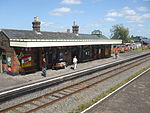Quainton Road railway station was opened in 1868 in under-developed countryside near Quainton, in the English county of Buckinghamshire, 44 miles (71 km) from London. Built by the Aylesbury and Buckingham Railway, it was the result of pressure from the 3rd Duke of Buckingham to route the railway near his home at Wotton House and to open a railway station at the nearest point to it. Serving a relatively underpopulated area, Quainton Road was a crude railway station, described as "extremely primitive".
The Duke of Buckingham built a short horse-drawn tramway to transport goods between his estates at Wotton and a terminus adjacent to the station. He extended it soon afterwards to provide a passenger service to the town of Brill, and the tramway was converted to locomotive operation, known as the Brill Tramway. All goods to and from the Brill Tramway passed through Quainton Road, making it relatively heavily used despite its geographical isolation, and traffic increased further when construction began on Ferdinand de Rothschild's mansion of Waddesdon Manor. The plan of extending the Brill Tramway to Oxford, which would have made Quainton Road a major junction station, was abandoned. Instead, the Aylesbury and Buckingham Railway and the Brill Tramway were absorbed by London's Metropolitan Railway (MR), which already operated the line from Aylesbury to London. The MR rebuilt Quainton Road and re-sited it to a more convenient location, allowing through running between the Brill Tramway and the Aylesbury and Buckingham Railway. When the Great Central Railway (GCR) from the north of England opened, Quainton Road became a significant junction at which trains from four directions met, and by far the busiest of the MR's rural stations.
In 1933 the Metropolitan Railway was taken into public ownership to become the Metropolitan line of the London Passenger Transport Board's London Underground, including Quainton Road. The LPTB aimed to move away from freight operations, and saw no way in which the rural parts of the MR could be made into viable passenger routes. In 1935 the Brill Tramway was closed. From 1936 Underground trains were withdrawn north of Aylesbury, leaving the London and North Eastern Railway (successor to the GCR) as the only operator using the station, although Underground services were restored for a short period in the 1940s. In 1963 stopping passenger services were withdrawn but fast passenger trains continued to pass through. In 1966 the line was closed to passenger traffic and local goods trains ceased using the station. The line through the station was singled and used by occasional freight trains only.
In 1969 the Quainton Road Society was formed with the aim of preserving the station. In 1971, it absorbed the London Railway Preservation Society, taking over its collection of historic railway equipment including many locomotives, and passenger and non-passenger rolling stock. The station was fully restored and reopened as a museum, the Buckinghamshire Railway Centre. In addition to the locomotives, stock, and original station buildings, the museum has also acquired the former Oxford Rewley Road railway station and a London Transport building from Wembley Park, both of which have been reassembled on the site. Although no scheduled trains pass through Quainton Road, the station remains connected to the railway network. Freight trains still use this line, and passenger trains still call at the station for special events at the Buckinghamshire Railway Centre.











